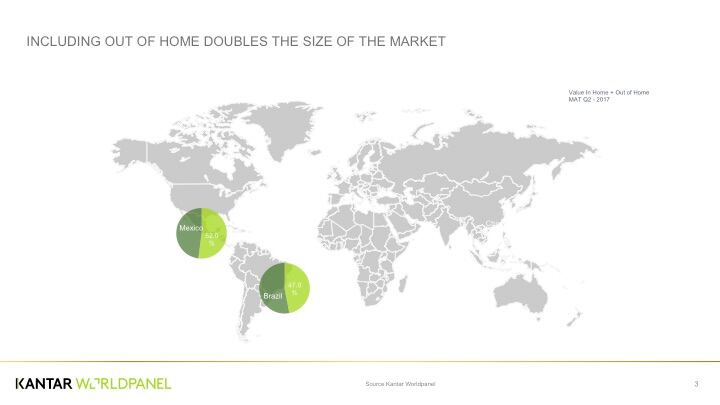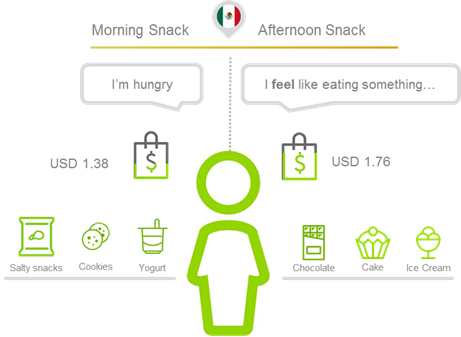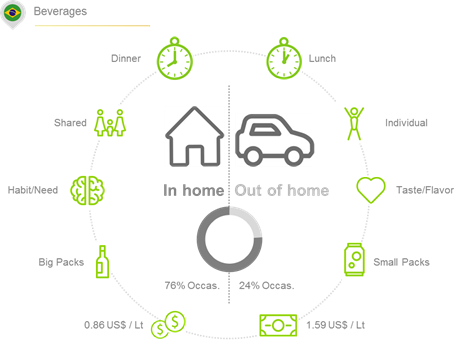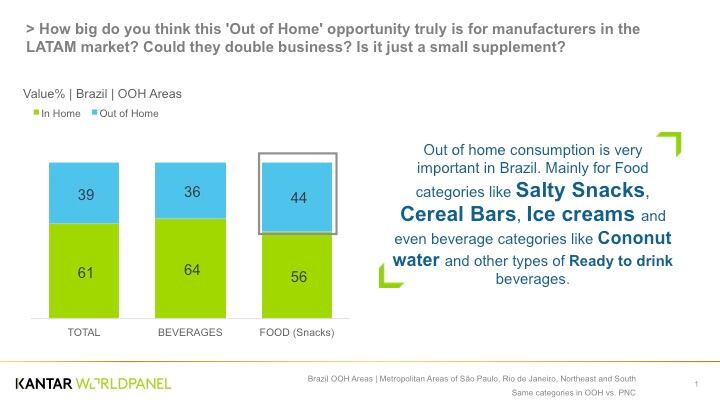Each year, consumers in Mexico eat or drink out of home (OOH) an average of 108 times and consumers in Brazil 68 times, according to Kantar Worldpanel.
Between October 2016 and October 2017, the OOH market in Mexico pulled in US$6bn and US$11bn in Brazil. These out of home occasions represented close to half of all food and beverage purchases in both countries – 52% in Mexico and 47% in Brazil.

“If your brand aims to succeed, then dominating consumer choices throughout the day is an obligation. If your comfort zone is currently ‘in home’, moving ‘out of home’ is mandatory,” said Kantar Worldpanel.
But, Mariana Cruz Díaz, OOH and Usage Food Manager at Kantar Worldpanel, said manufacturers had to consider several things before shifting or expanding.
Is the product relevant?
Díaz told FoodNavigator-USA: “The out of home market is huge and needs differentiated strategies in terms of sizes, flavors and even practicality.
“…Versions of product that might be relevant at home might not be for OOH consumption. For example, talking about salty snack product presentations above 70 grams would be irrelevant for on-the-go consumption in Mexico; it’s impractical considering consumption occasions are individual most of the time,” she said.
Half of all Mexico’s OOH occasions were not shared with anyone, she said, and only 28% of occasions saw a product shared between two people.
Spending amongst female consumers in Mexico also varied according to the time of day, Kantar Worldpanel data showed, with consumers spending, on average, 30% more for afternoon snacks compared to those purchased in the morning (US$1.76 versus US$1.38).

OOH lunchtime beverage purchases in Brazil, for example, were driven by a consumer desire for taste, flavor and smaller packaging, data suggested. This compared to habitual purchases and the need to share when buying drinks to consume at home.

Díaz said understanding how and why OOH occasions took place, no matter what product or market, was highly relevant for manufacturers.
Manuela Bastian, expert solutions director for Brazil at Kantar Worldpanel, agreed.
“To grow OOH, manufacturers need to understand the motivations and occasion… In my opinion, they can use the same brands but it is necessary to focus on packaging that facilitates consumption on-the-go; be it size, price, convenience or storage,” she said.
Homemade and healthy…
Bastian said there were a couple of obvious opportunity areas in the OOH market.
“In Brazil, it is worth mentioning that the consumption of homemade snacks is very important. It is possible to see a potential for the industry to occupy [this space].”
There was also a significant opportunity, she said, to drive down the price of healthier out-of-home snacks.
“The health issue is a general trend, however, outside the home it is more difficult to eat healthy, especially when we think of snacks. Aside from having few healthy product options, the options that exist are too expensive. So, the industry should focus on developing that,” she said.

For promising profits, OOH sales of carbonated soft drinks (CSD) were a good focus in Brazil, she added.
Whilst just 45% of CSD purchased in Brazil were for OOH consumption, the value of these occasions represented 57% of total purchases.
“We believe that in some categories there is still the opportunity to exploit consumption outside the home in order to take better advantage of the products’ profitability,” Bastian said.
Cecilia Alva, clients and new business director for LATAM at Kantar Worldpanel, said a lot of opportunity lied in trying to grow occasions where ‘homemade’ or unbranded products were consumed.
When developing such products however, she said distribution, packaging and price were all “critical”, along with communication that connected to the specific reasons behind out of home consumption.
Opportunity widespread
Díaz said that whilst premium brands could be perceived as having the most opportunity to grow, all brands still had a chance by leveraging “untapped targets, needs or moments of consumption”.
When doing so, she said it was also important to consider the best point of distribution for the product.
Whilst c-stores like OXXO – Mexico’s largest chain – were heavily increasing presence and seemed a logical outlet for OOH products, she said almost half of OOH occasions still came from traditional channels.
“It is important for manufacturers not to forget about the traditional stores and supermarkets. Convenience stores might be increasing but not yet enough to dethrone modern channels,” Díaz said.
Bastian said it was also helping that many retailers across LATAM were “shaping up” to cater for on-the-go consumption with dedicated store spaces, refrigerators and even specialized stores like Hirota Foods in Brazil.
Díaz said: “If there’s the habit of out of home consumption and the economy, or perception of it, is solid and we add the factor of having a proper offer of products satisfying consumer needs, there will always be a promising out of home market.”
